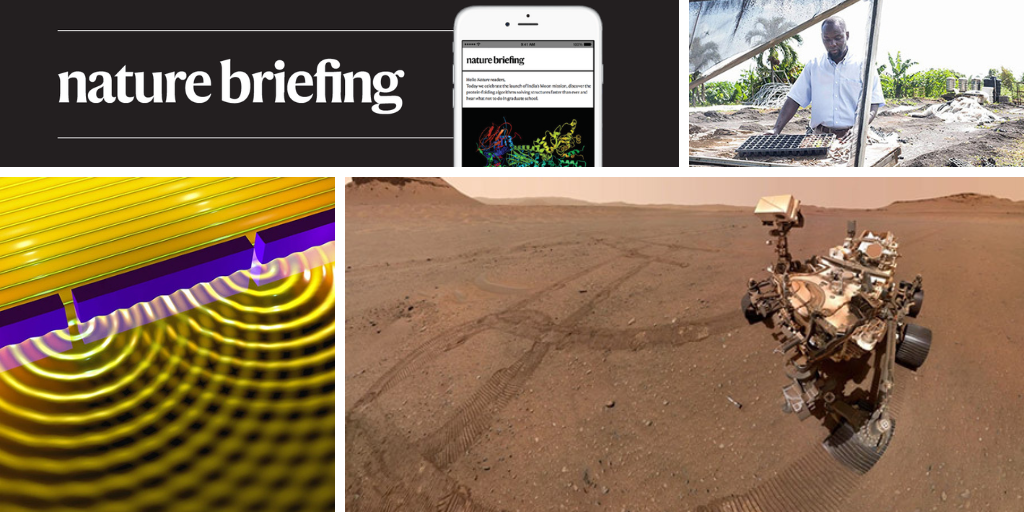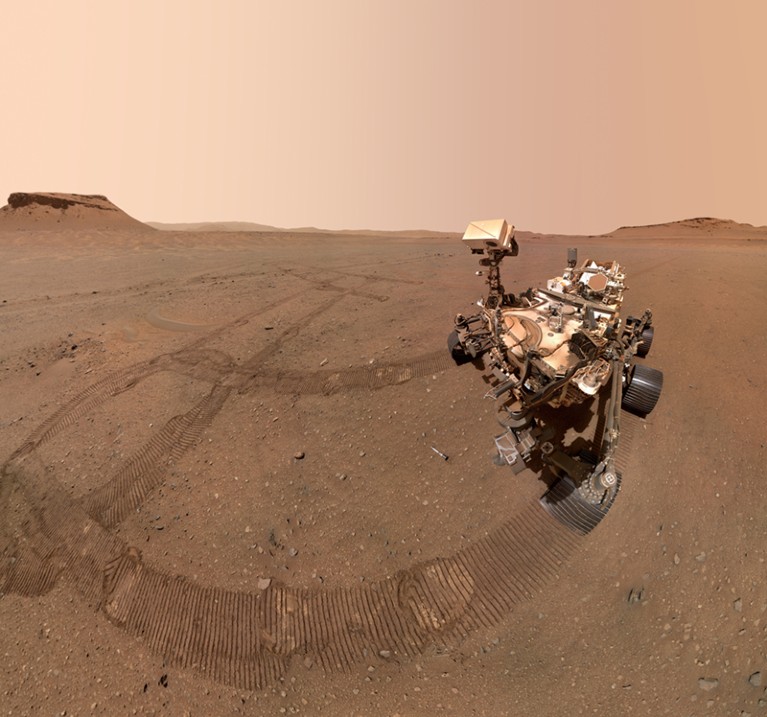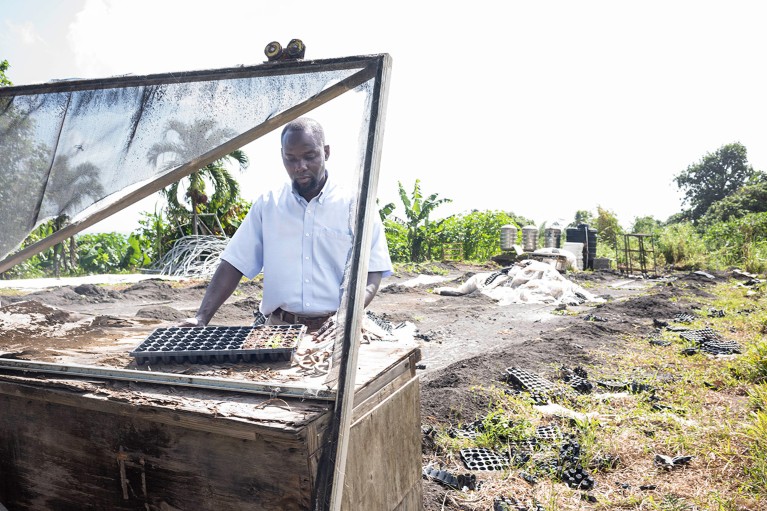Hello Nature readers, would you like to get this Briefing in your inbox free every day? Sign up here
NASA’s Perseverance rover took a selfie on 22 January as it deposited one of a number of sample tubes (visible at the rover’s base) on a flat area of Jezero Crater.Credit: NASA/JPL-Caltech/MSSS
We might finally be on track to receive rock samples from the surface of Mars — but only if NASA and the European Space Agency can pull off a fiendishly complex mission. NASA’s Perseverance rover has gathered tubes filled with rock, soil and air from the Martian atmosphere, all ready for pickup. Last month, NASA said it wants to allocate nearly US$1 billion to the sample-return mission, sending ripples through the US space budget. It will involve a lander to get to Mars, mini-helicopters to grab the samples, a rocket to launch them into space and an orbiter to return them to Earth.
Just when we thought ozone-destroying chlorofluorocarbons (CFCs) were a thing of the past, atmospheric chemists have found a troubling signal in recent data: the levels of five CFCs rose rapidly from 2010 to 2020. Their collective annual warming effect on the planet is equivalent to the emissions produced by a small country such as Switzerland. “This shouldn’t be happening,” says atmospheric chemist Martin Vollmer, who helped to analyse data from an international network of CFC monitors.
Reference: Nature Geoscience paper
A celebrated experiment in 1801 showed that light passing through two thin slits interferes with itself, forming a characteristic striped pattern on the wall behind. Now, physicists have shown that a similar effect can arise with two slits in time rather than space: a single mirror that rapidly turns on and off causes interference in a laser pulse, making it change colour. The result adds a new twist to the classic double-slit experiment first performed by physicist Thomas Young.
Reference: Nature Physics paper
Parts of the brain associated with habit formation seem unusually active in people with some eating disorders. Researchers first looked at human brain scans to identify regions that might be analogous to the areas that are active in laboratory rats when they perform habitual behaviours. This led them to two structures: the sensorimotor putamen and the associative caudate. The team then examined the brains of 34 women with binge-eating disorder or bulimia. Connections between some parts of the cortex and the habit-reinforcing putamen were much stronger than in healthy controls. Their putamen also had fewer receptors for dopamine, a neurotransmitter released in response to reward. It could explain why bulimia and binge-eating disorder are often resistant to treatment.
Reference: Science Translational Medicine paper
Features & opinion
Researchers are looking to drug combinations, vaccines and gene therapy as they forge the next generation of treatments for Alzheimer’s. Hopes have been buoyed by a long-sought success: an antibody drug called lecanemab slows mental decline enough to give people a few extra months of independent living. “But actually conquering a destructive disease that affects tens of millions of people worldwide is a different story,” notes neurologist Reisa Sperling.
If everyone on Earth planted a tree — 8 billion trees — it would turn the world’s carbon dioxide emissions clock back in time by about 43 hours every year, once the trees had matured. Each of the four carbon dioxide removal hubs under development in the United States would turn back the emissions clock by only 13 minutes per year. The comparison highlights that carbon dioxide removal is a drop in the bucket compared with society eliminating its polluting activities, argues oceanographer David Ho.
Where I work
Rohan McDonald is a tropical agriculture researcher at the Orange Hill Agricultural Biotechnology Centre, St Vincent and the Grenadines.Credit: Micah B Rubin for Nature
Agriculturist Rohan McDonald is rebuilding a medical-cannabis laboratory in St Vincent and the Grenadines after the La Soufrière volcano eruption destroyed his team’s work. He uses tissue culture — which involves growing plantlets from cuttings under sterile, controlled conditions — to produce disease-free, female plants. Only females have the cannabinoid-rich flowers needed for medicinal products. “The government mantra is to ‘build back better’, so we will have two large temperature-controlled greenhouses equipped with solar panels, and a secure lab for our cannabis research, designed to be more resistant to eruption damage,” says McDonald. (Nature | 3 min read)
Today I’m waving at this sinuous, translucent snailfish (genus Pseudoliparis) — the deepest fish ever filmed. It was observed swimming at 8,336 metres in the Izu-Ogasawara Trench, off the coast of Japan.
While I enjoy the sight of life frolicking at great depths, why not send me your feedback on this newsletter? Your comments, whether positive or critical, are always welcome at [email protected].
Thanks for reading,
Flora Graham, senior editor, Nature Briefing
With contributions by Katrina Krämer and Gemma Conroy
We’ve recently launched two new e-mails you might like. They’re free, and of course you can unsubscribe at any time.
• Nature Briefing: Cancer — a new weekly newsletter written with cancer researchers in mind. Sign up here to receive the next one.
• Nature Briefing: Translational Research covers biotechnology, drug discovery and pharma. Sign up here to get it free in your inbox each week.








More News
Author Correction: Stepwise activation of a metabotropic glutamate receptor – Nature
Changing rainforest to plantations shifts tropical food webs
Streamlined skull helps foxes take a nosedive